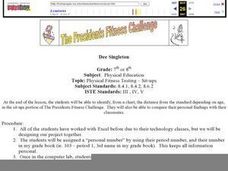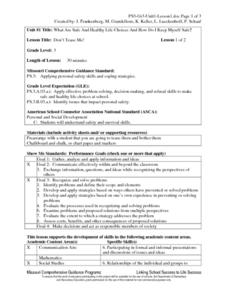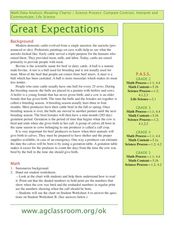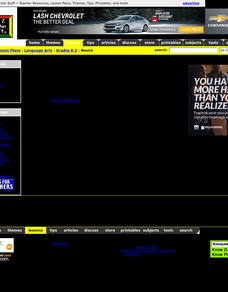Curated OER
Eminent Domain: Whose Land is it Anyway?
Students research eminent domain and whether or not there has been a land dispute in their community. Students search local newspapers, local history books or talk with civic leaders and long-time citizens and create a chart showing the...
Curated OER
The President's Fitness Challenge
Young scholars identify, from a chart, the distance from the standard depending on age, in the sit-ups portion of The Presidents Fitness Challenge. They will also be able to compare their personal findings with their classmates.
Curated OER
Don't Tease Me!
Third graders observe as the teacher pretends to tease a student and try to describe what the problem is. They brainstorm times when they felt unsafe at school either physically or emotionally and write down their responses on the board...
Curated OER
Prime and Composite Numbers - Kenwood Academy
Learners investigate prime and composite numbers. They use a number chart and cross out multiples of 2,3,5 etc. up to 100. Pupils fold pieces of masking tape around pennies and label them with composite numbers, then fold masking tape...
Curated OER
Genealogy Research
Students explore history is not as a listing of dates, wars, and leaders but as the story of real people whose lives were impacted by the events of their time. They complete a pedigree chart and tape record a family member.
Curated OER
Recycling: The Way to Save...Fad or Fact
Students write stories about recycling and illustrate them. They examine various containers and determine whether or not they are recyclable. They make a chart about the containers and visit a recycling center.
Curated OER
Whose money is it?
Students perform research on the Web, in books and by contacting lawyers to find out what steps the court goes through to decide who gets the money. They create a chart to illustrate what laws or policies the court follows.
Curated OER
Apple Graphing
Do you like apples? Create a taste test for your first and second grade learners. Cut red, green, and yellow apples, and have learners select their favorite. After tasting all of the apples, they collect data and graph the results with...
Curated OER
All About Me: Measuring Height and Weight
Learners take personal fitness inventories. In this personal health lesson, students take measurements of their heights and weights. Learners record the data, calculate their BMI, and then chart their physical activity.
Curated OER
Pass It Down
Students in varying grades work cooperatively to create a living museum of items that have been "passed down" through generations. They give a brief oral presentation showing their object (or a picture of it) and describing its history...
Curated OER
Acting Like a Third Grader
Third graders practice acting like a thrid grader. They performa a skit to demonstrate the skills and behaviors used by 3rd Grade students to succeed in school.
Curated OER
Weather Reporting
Students locate a weather map on the internet and explain or predict the weather for the following day. Students interpret the information on the weather map and pick the correct clothing to wear for that day. Students chart and graph...
Curated OER
Great Expectations!
Second graders participate in a game that focuses on appropriate and inappropriate behavior for second grade. They draw a game card and read it out loud, and students discuss and identify the behavior as appropriate or inappropriate....
Curated OER
Vowel Sounds
This plan aims to increase the reading proficiency of your fourth grade class. While no materials are provided, a list of activities to practice are included. Various activities include creating songs for short vowel sounds, using cue...
Curated OER
Creating Climographs
Students chart statistical information on graphs, interpret the information and use it to explain spatial relationships, and identify the relationship between climate and vegetation.
Curated OER
The Role of the Judiciary in a System of Separation of Powers and Checks and Balances
Students review concepts shown to them in a telecast on the role of the judiciary in a system of separation of powers. After reading an article, they work together in groups to complete a chart on checks and balances. They also discuss...
Curated OER
Comparing Good and Bad Character Traits of Historical and Current Figures
Students create a chart with two columns. In one column include good and bad character traits of historical figures in biographies and historical fiction. In the second column include good and bad character traits of current famous...
Curated OER
Cause and Effect
In groups, learners they look for key words to help locate a cause and effect relationship. They create a t-chart with the information they discover and share it with the class.
Curated OER
Time Line of the Year
Students record special events and memories on a timeline of the school year. In this timeline instructional activity, students understand the purpose of a timeline as they chart important events of the school year using photos,...
Curated OER
Elmer by David McKee
Students explore individual differences. For this literacy and self-esteem lesson, students listen to the story Elmo by David McKee, then describe what characteristics make Elmo special. Students complete a T chart showing how Elmo...
Curated OER
Reading With Fluency And Expression
Practice makes perfect, and this lesson provides a rubric to prove it! To improve their ability to read with fluency and expression, readers listen to a series of online stories in order to hear how a well-read story should sound. They...
Curated OER
The Fabric of Our World
Middle schoolers discuss cultural diversity, and examine how the community reflects the cultural background of the inhabitants. They read the book, People, take a community walk, create a rainbow chart, and research other states for...
Curated OER
Nouns
Young readers practice classifying nouns for people, places and things. They are read a story by their teacher and identify any nouns they remember. They create a chart on the board and place them in their proper category.
Curated OER
What are the Elements of Poetry
Students read the poem "Ode to Pablo's Tennis Shoes" and analyze the form, figurative language, and mood. They complete a T-chart containing what they have learned about Pablo and the evidence from the poem supporting their conclusions.



